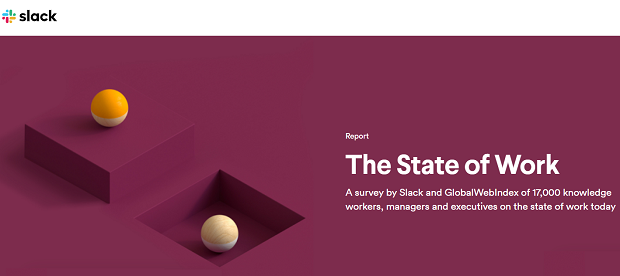
Nearly two-thirds (64%) of workers spend at least 30 minutes per day switching between apps, with ‘streamlined information’ key to effeciant meetings and emails within business-to-business firms, according to new research.
The study, from GlobalWebIndex, looked into how professional and consumer behaviours collide.
The first study to leverage the new Working Professionals dataset, commissioned by Slack Technologies, explores “The State of Work” with insights from a dedicated B2B panel of 17,000 respondents overlaid with 40,000 existing data points from the GlobalWebIndex core dataset.
“The demands on knowledge workers are manifold – analytical thinking, innovation, active learning, creativity, critical thinking, collaboration and complex problem-solving all demand their time and attention,” says Jason Mander, Chief Research Officer at GlobalWebIndex. “To be effective, workers need more transparency into the strategic objectives of their organization — they need a line of sight into the company’s North Star. With this new B2B research capability, we aim to provide leading organisations of all sizes with a data-led, actionable understanding of the employee and consumer requirements their business outcomes rely on.”
Christina Janzer, Director of Research and Analytics at Slack adds, “In today’s fast-paced, high-pressure world of work, the immediate impulse is often to try and manufacture alignment by doubling down on communication for communication’s sake. This research illustrates that by streamlining information and helping workers communicate and use their time more efficiently, businesses can bring increased alignment and productivity to the workplace.”
Top findings of The State of Work report include:
The benefits of an aligned workforce are readily apparent — aligned workers have a clear understanding of their company’s strategy, their own personal goals and how those two things connect. 90% of them know what they need to do in their roles to be successful.
‘The Alignment Paradox’ puts 325,000 hours of productivity at risk if not addressed carefully — globally, collaboration and communication must be improved, but organisations must refine, not simply add to, alignment strategies; 64% of workers spend at least 30 minutes per day switching between apps, amounting to 325,000 hours of lost annual productivity for an enterprise of 2,500 employees working 260 days per year.
Hourly communication with co-workers, 3-4 meetings per day and quarterly goal-setting create the most aligned workers — these parameters resulted in workers being the most aligned with their company’s vision, values and principles, and in turn being more engaged with contributing to its progress.
A combination of team meetings and collaborative channels provides the most effective communication — while workers report meetings and email announcements are most useful for delivering strategic communications, collaborative channels offering two-way communication are key to helping them understand the strategies.
Slack’s State of Work Report leverages this data to better understand the experience of modern workers and how they want their employers to set them up for success. Specifically, what do aligned workers look like, why does having aligned workers matter, and how do companies attract and retain aligned workers?
<strong>Methodology</strong>
In 2019, Slack partnered with market research firm GlobalWebIndex to undertake multi-market, quantitative research designed to understand the views of knowledge workers as well as the trends impacting the future of the workplace.
Slack and GlobalWebIndex co-designed the questionnaire, which GlobalWebIndex then fielded as an online, 20-minute survey to 17,000 knowledge workers across 10 markets. The surveyed population spanned an age range of 16-64 years; more than 40 industries; all company sizes; and all career levels (from skilled/semi-skilled workers and office staff to senior executives).
<a href=”www.slack.com/state-of-work”>View the report here</a>
